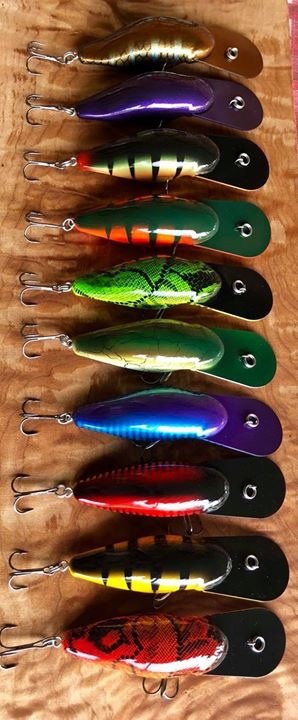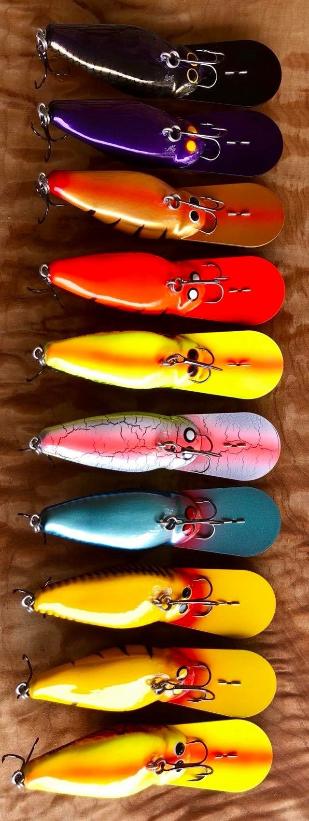Deception Lures - Paul Kneller - NSW:
Paul Kneller has been making lures since 1991 and is well known for developing the Deception range of lures, many of which resemble crayfish, prawn or large shrimp lures. Deception lures were quickly accepted by the Australian anglers in the 1990's and the patterns evolved over time. There are many variations both in bib types and hanger arrangements within the same model. Paul is also a great experimenter and there are many one off examples or experimental models.
This page would not have been possible without the help of Rob 'Lure Nut' Dunn who is a specialist Deception collector and is developing his own website for Deception lures
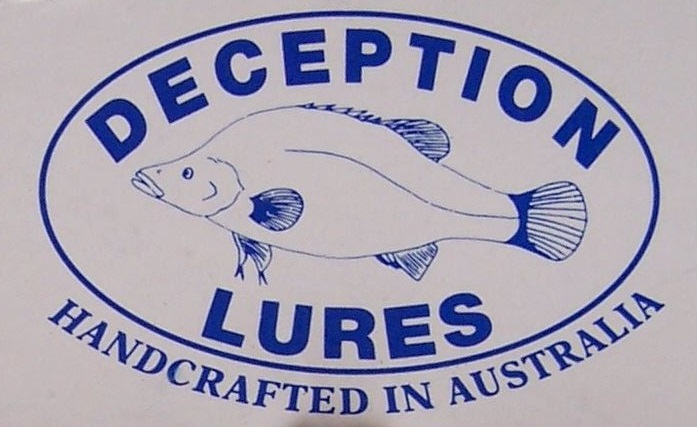
(Right) - A very early business card for Deception Lures when Paul and Cheryl were based in Campbelltown.
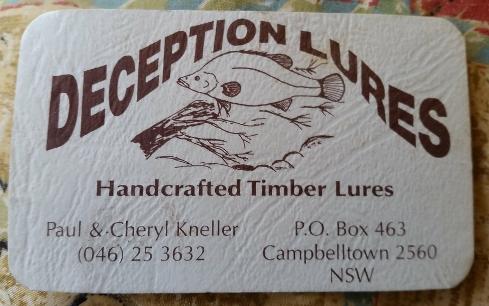
The Deception 'Yabby':
The 'Yabby' pattern is one of the earliest Deception models and dates to 1991. The earliest versions will have a very distinctive body shape and bead eyes. The lure evolved into a smoother body shape over time.
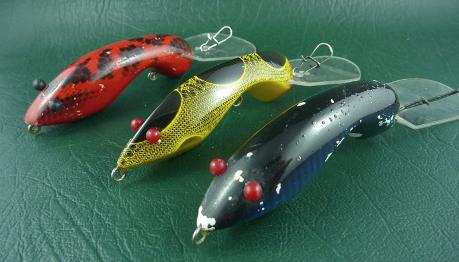
(Above) These are three of the first 'Yabby' shapes that were made by Deception Lures. The red Yabby (round back, round belly), the yellow Yabby (angled back, angled belly) and the green/blue Yabby (round back, angled belly). The pair of Deception Yabby lures shown below have a story behind them that was explained by Paul in 2009. The belly hooks were fitted with a double hook as opposed to a treble.
'I did do some Yabbies with the VMC double hook, to try to eliminate the treble from hanging up on the side. Just morphed it into the Cherax instead. Yabbies were made before the Shrimp, Those would be around 18 years old' sic (c.1993?) Paul Kneller.
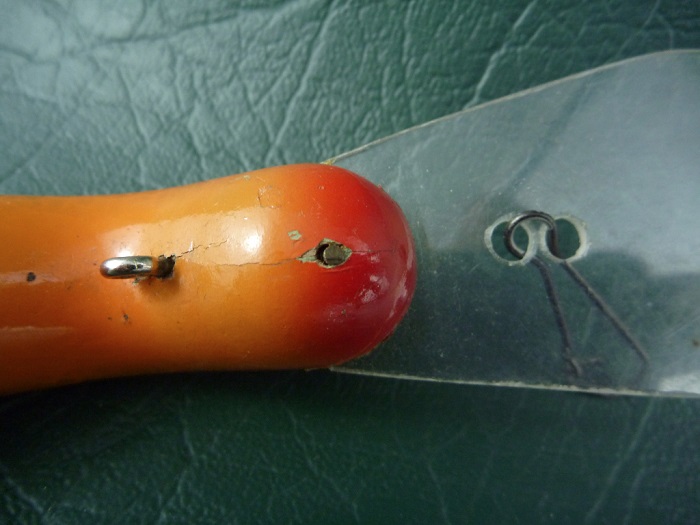
(Above) Examples of the rare early 'Yabby' which were fitted with bead eyes. You will also note some bib variations in this lot with some having a straight bib while others have bibs with a straightened section as shown.
(Below) An early Deception 'Yabby' with fluted bib which is an extremely uncommon variation of this model.
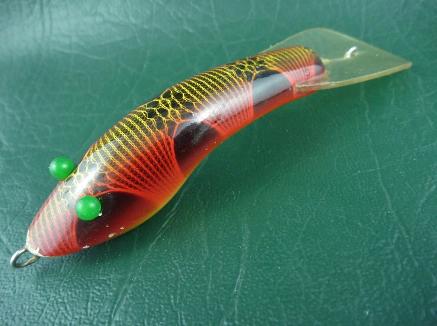
(Below) The pinned bib 'Yabby' has the earlier version of the bib but also has screw in hangers. Unknown exact date but definitely early 1990's. This would have been done as Paul was not completely happy with the bib strength on the 'Yabby' model.
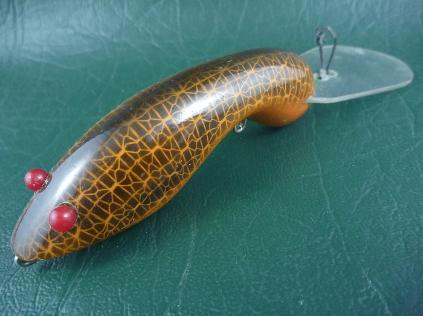
(Below) Examples of early Deception 'Yabby' colours and variations of shape. The majority of these lures will all have twisted wire hangers as opposed to commercially supplied screw in hangers however screw in hangers were used in the earliest versions with the bead eyes while later versions with painted eyes will have twisted wire hangers.. The body shape changes over time as showed in this series of photos.
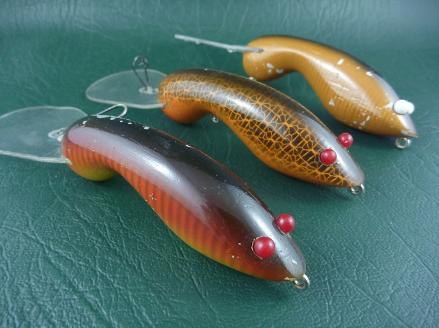
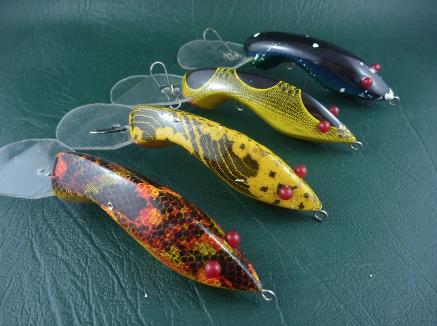
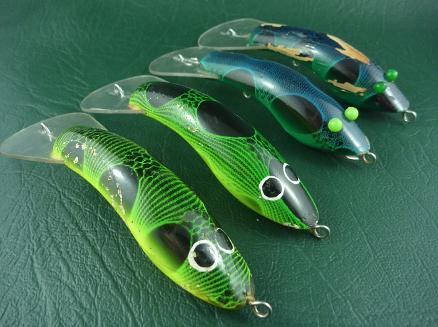
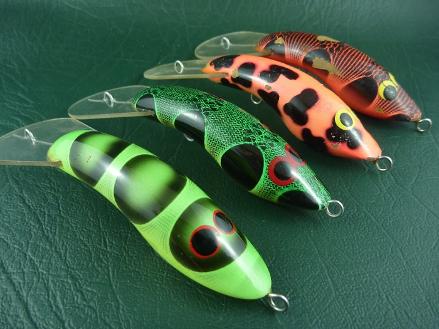
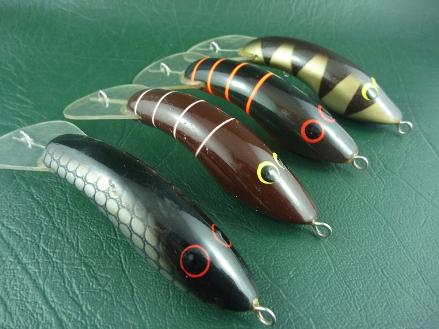
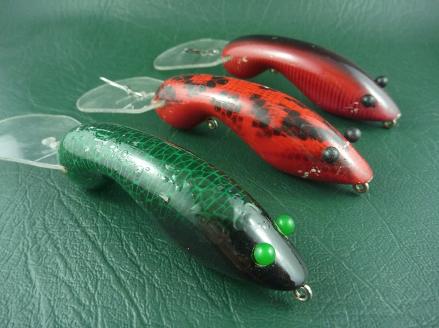
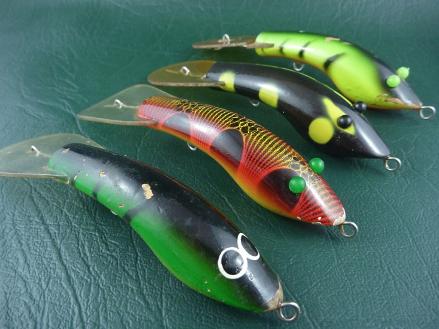
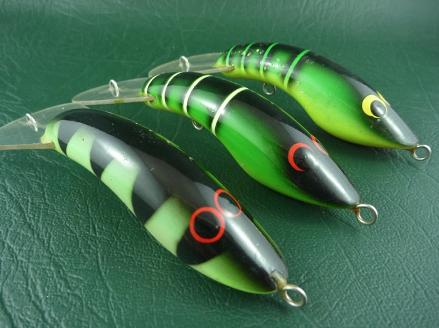
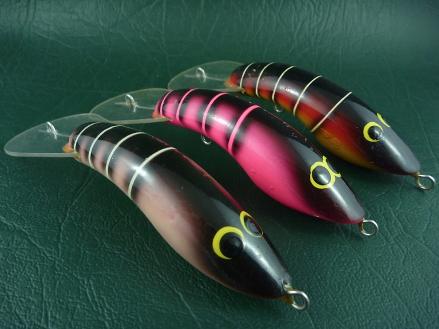
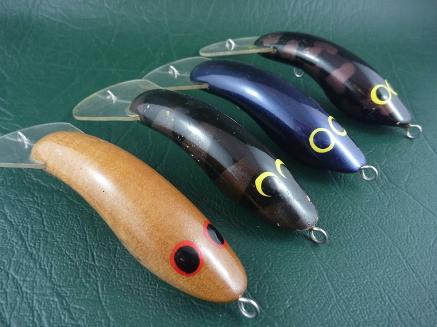
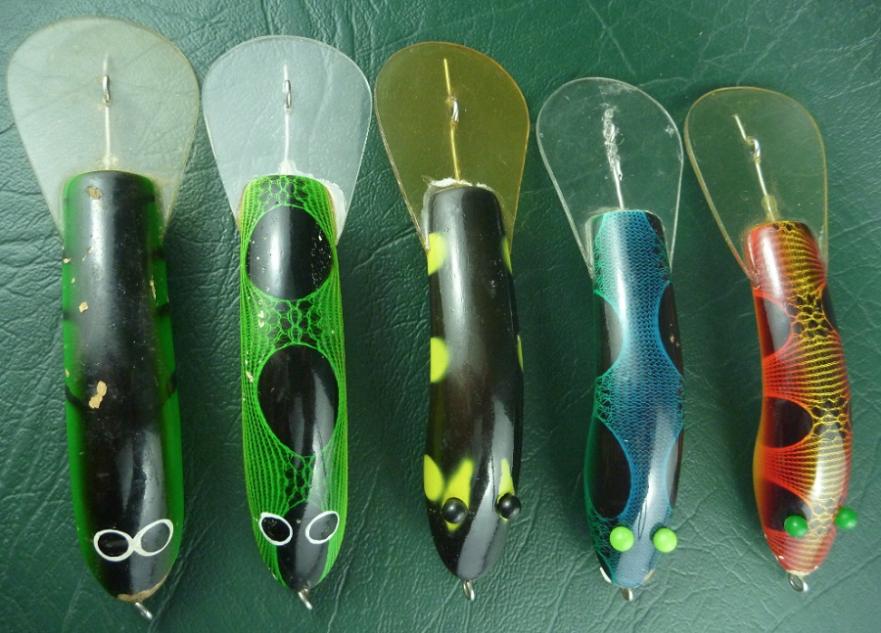
(Above) Deception 'Yabby' square tails with a less tapered and rounded rear end to the lure shape
The Deception 'Cherax':
The 'Cherax' pattern is a larger version of the 'Shrimp' model and is a Deception model that evolved from the earlier 'Yabby'. The Deception Cherax is 85-90mm long and was primarily aimed at Golden Perch (Yellowbelly) and Murray Cod. It appears that there are 10 different models/variants. The 'Yabby' was an earlier version that preceded the Cherax from a similar size perspective.
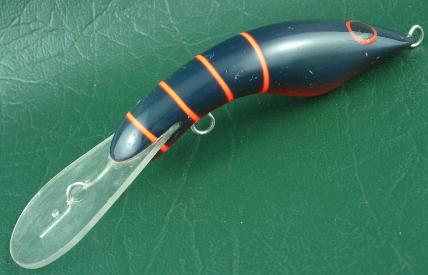
CX010 Cherax - Early Series, White Beech, 90mm, Bib Deep 1.5 mm x 33mm x 35mm, Through Wire Towpoint, Twisted Wire Hangers, Pilot hole in bib
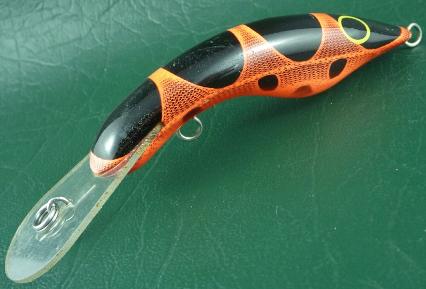
CX030 Cherax - Short Narrow Bib, White Beech, 90mm, Bib Deep 1.5 mm x 30mm x 31mm, Wire Staple Towpoint, Twisted Wire Hangers
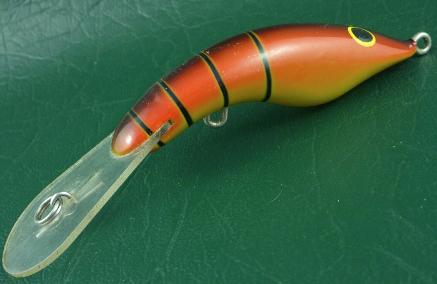
CX050 Cherax - Narrow Bib, White Beech, 85mm, Bib Deep 1.5 mm x 30mm x 35mm, Wire Staple Towpoint, Screw Hangers
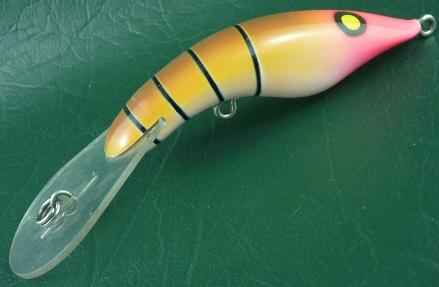
CX070 Cherax - Wide Bib, White Beech, 85mm, Bib Deep Straight, 1.5 mm x 36mm x 34mm, Wire Staple Towpoint, Screw Hangers
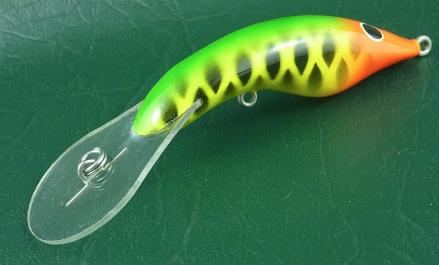
CX090 Cherax - Wide Bib, White Beech, 85mm, Bib Deep Round, 1.5 mm x 36mm x 34mm, Wire Staple Towpoint, Screw Hangers, Smaller Middle Hook Screw Eye
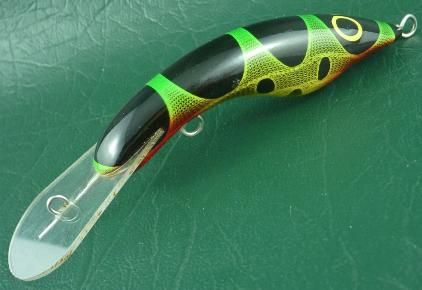
CX020 Cherax - Short Narrow Bib, White Beech, 90mm, Bib Deep 1.5 mm x 30mm x 32mm, Through Wire Towpoint, Twisted Wire Hangers
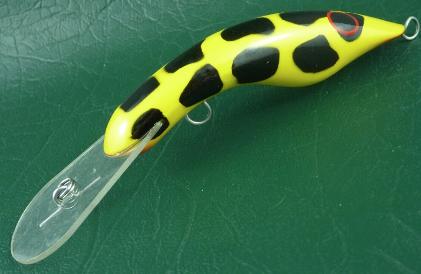
CX040 Cherax - Narrow Bib, White Beech, 90mm, Bib Deep 1.5 mm x 30mm x 35mm, Wire Staple Towpoint, Twisted Wire Hangers
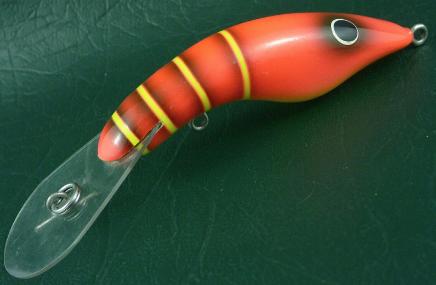
CX060 Cherax - Wide Bib, White Beech, 85mm, Bib Deep Straight 1.0 mm x 36mm x 34mm, Wire Staple Towpoint, Screw Hangers, Smaller Middle Hook Screw Eye
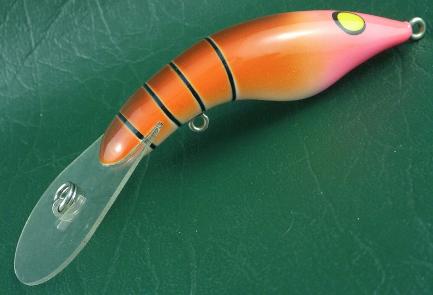
CX080 Cherax - Wide Bib, White Beech, 85mm, Bib Deep Straight, 1.0 mm x 36mm x 34mm, Omega Plate Towpoint, Screw Hangers, Smaller Middle Hook Screw Eye
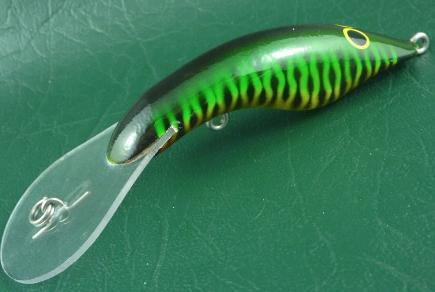
CX100 Cherax - Wide Bib, White Beech, 85mm, Bib Deep Round, 1.5 mm x 36mm x 34mm, Wire Staple Towpoint, Screw Hangers.
(Below) Colour variations for Deception 'Cherax' models
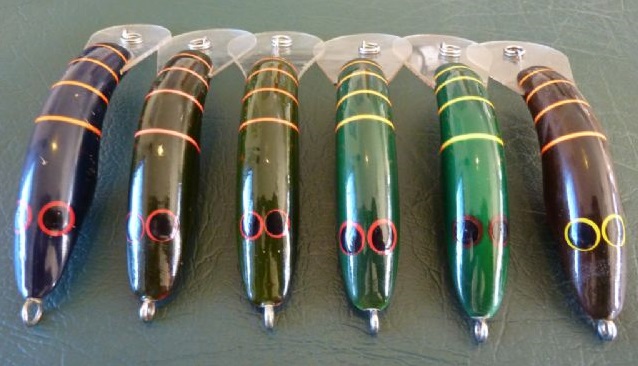
(Below) The 'Cherax' models shown illustrate a simple bib variation with a wider bib used on the bottom lure.
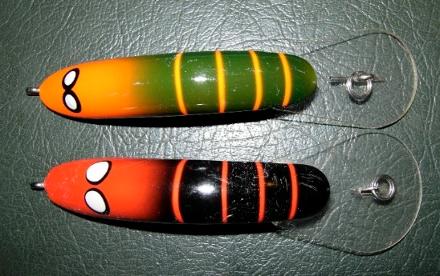
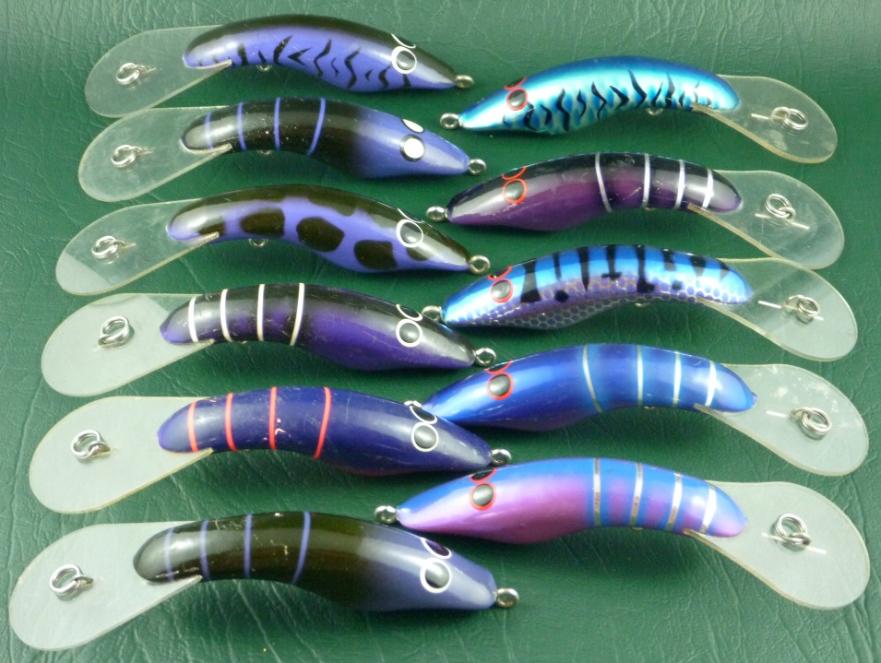
The Deception 'Whitmore Shrimp':
The 'Whitmore Shrimp' pattern dates t0 1993 and is one of the earliest Deception models. It preceded the 'Shrimp'. Shown right is a review from Freshwater Fishing magazine in 1993 which talks of the earlier 'Yabby' pattern which is shown as a smooth bodied version next to a 'Whitmore Shrimp'
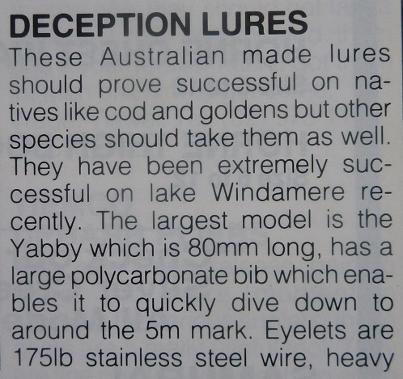
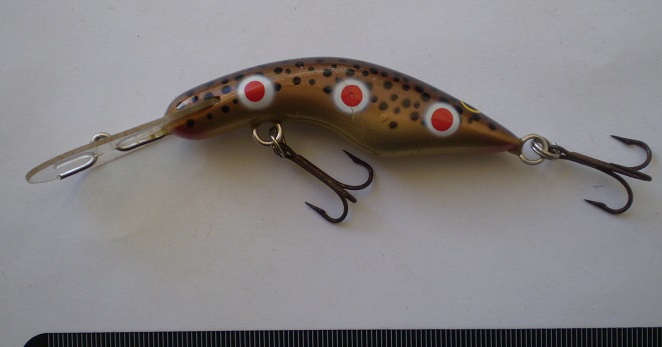
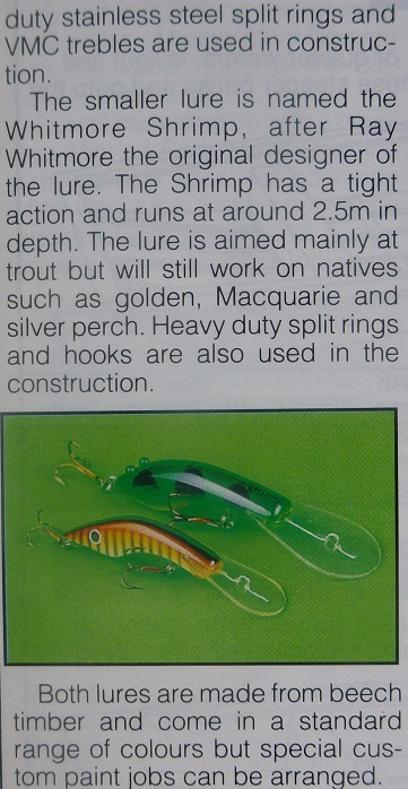
The Deception 'Cutlet Bone Shrimp':
The 'Cutlet Bone Shrimp' pattern is a variation that was developed as an early 'Shrimp' pattern. It has much flatter sides than the later 'Shrimp' pattern and is through wired on the bib with twisted wire hangers.
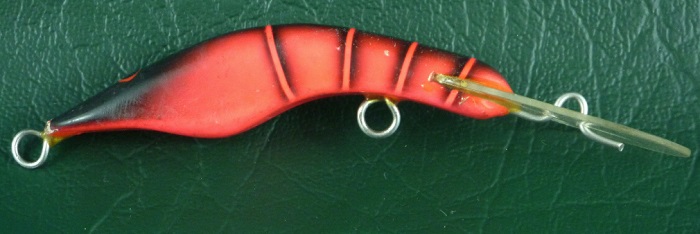
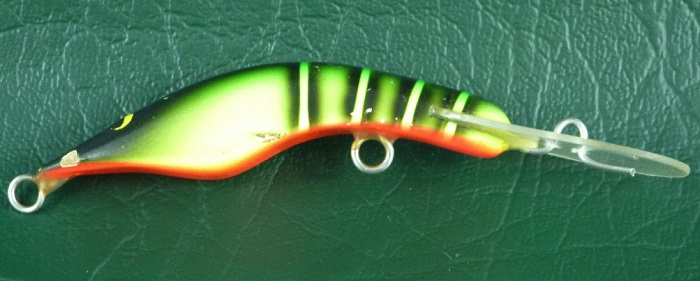
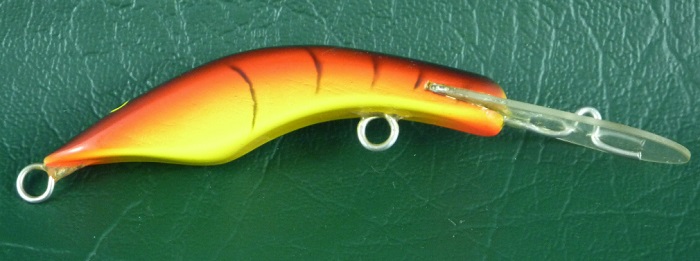
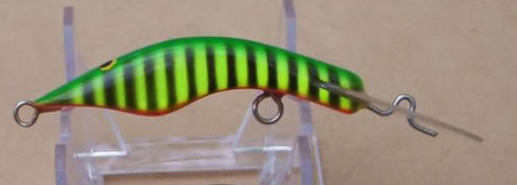
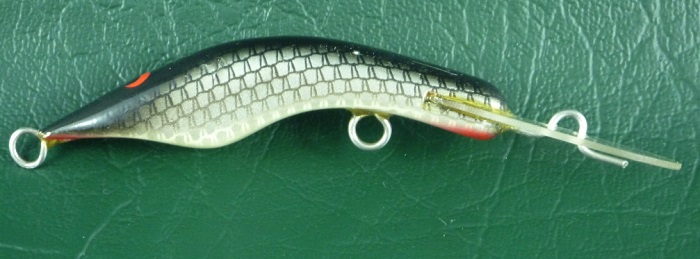
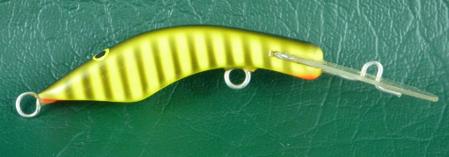
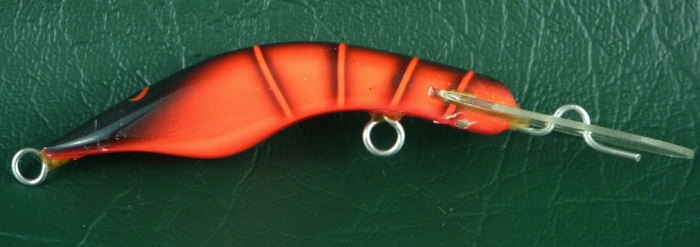
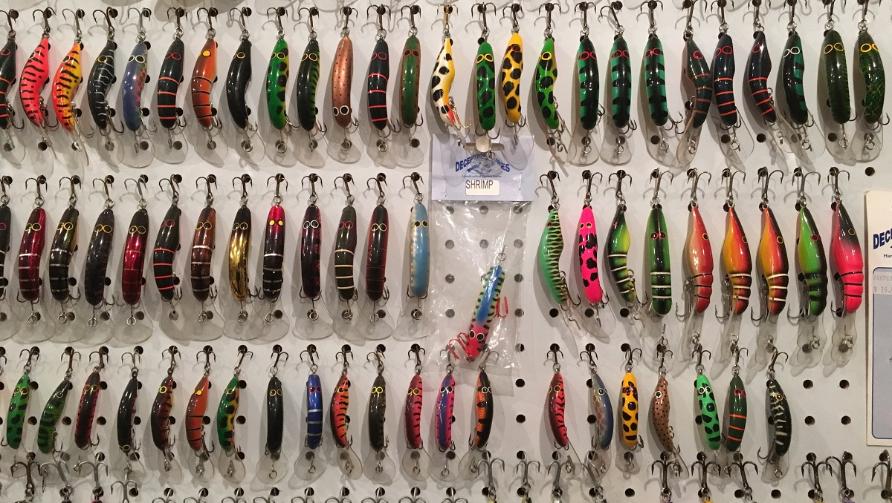
The Deception 'Shrimp':
The 'Shrimp' pattern is one of the earliest Deception models and was being developed around 1992/3. They are easily identified and should be a length of 70mm (body only). This was the model that took Deception lures into the mainstream market.
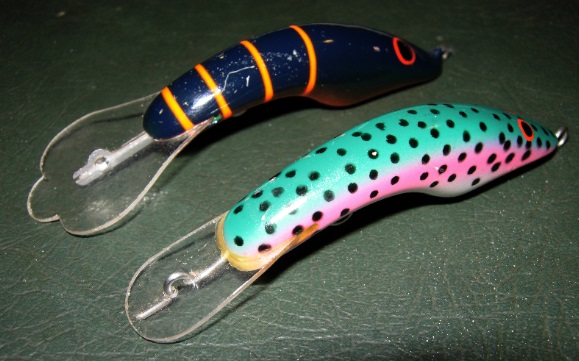
(Above) Shrimp variations - Something very different which have been confirmed by Paul as originals and made with a special purpose in mind.
- The fluted bibbed 'Shrimp' in black and red is a skeleton style and typical of the bib style found on the later Cherabins.
- The mini bibbed 'Shrimp' in Rainbow is a through wire twisted hangers version designed for the shallows.
It is these variations found in Deceptions that make them so collectible
Below shows three more 'Shrimp variations which includes;
Top - 'secret squirrel' after market bib -a deep diving special.
Middle - straight bib typically with staple tow point and twisted wire hangers
Bottom - straight bib with skeleton and balsa body - unique.
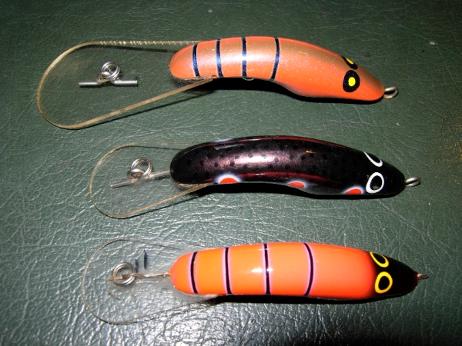
The 'Shrimp' below is an early blank c. 1993. Right shows some evolution of the 'Shrimp' moving from twisted wire hangers onto the skeleton inserts.
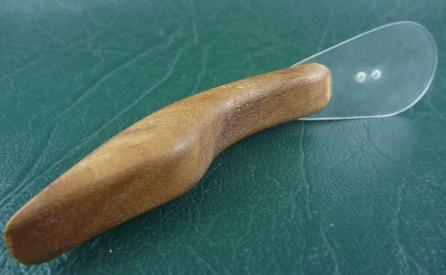
The 'Shrimp' above shows the packaging for the Deception range after the first type of packaging in 1992. ???
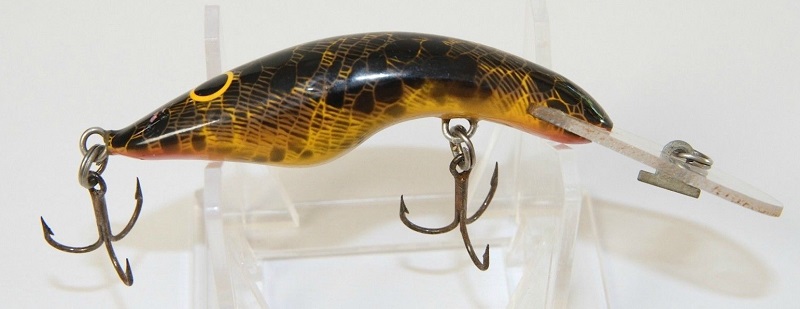
The lure below is a Deception 'Shrimp' model with a handmade skeleton that was made from Zincalume;
''I was considering at one
stage making the shrimp from Balsa, but the skeleton would have had to
have been much bigger to counteract the buoyancy of balsa. So this was
the only shrimp I ever made from it. On the first few batches I did with
the skeletons, I kept the bib slot the same depth, I soon realised I
could basically half the depth of the slot, without losing any diving
depth but increasing wobble slightly.'' Paul Kneller
More history about this lure from Paul;
''I don't think there would be many, if any more out there? I guess as history shows I opted for action and castability over absolute depth, by using a smaller bib. Also the bigger bib used to want to dig in and dive deep into the weed, which was not a good attribute walking the banks of Windamere. The smaller bib allowed the lure to actually swim up towards the surface, it was on this change of direction that any following yellas would nail it, and that was the Shrimp's deadly weapon on Goldens they were a sucker for the pause and upward swimming change of direction''.
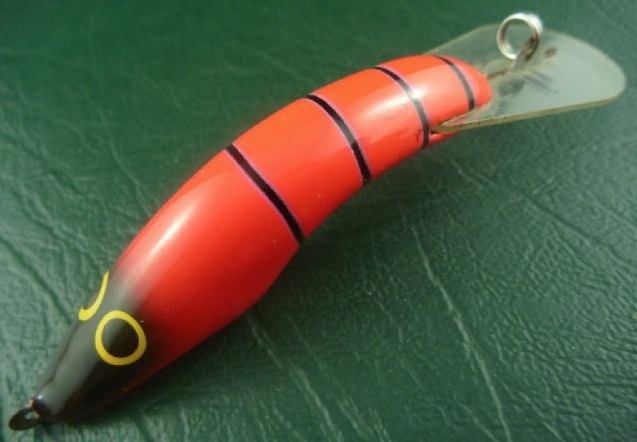
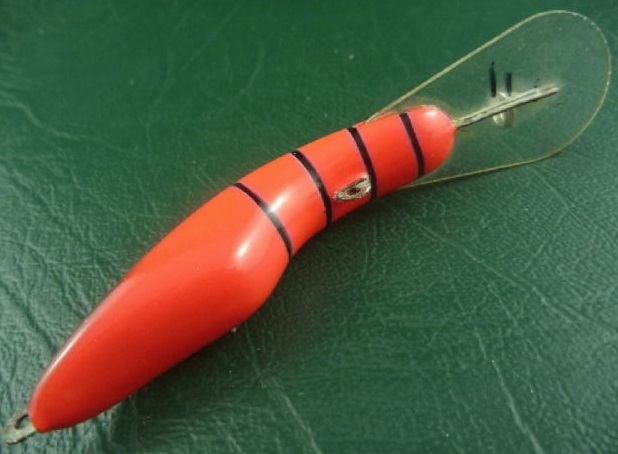
An explanation about the bib differences and variations within the same models was explained by Paul in response to some questions on the Lure Lovers forum.
''I guess when Frank's excellent "Lures in Depth" series of books was published there was a perceived misconception that the lure that dived the deepest, sort of won! I guess the format of the book made it look a little like that? I reckon Frank seen that as well, and remember a chapter dedicated to debunking the myth, stating that the Bennett/McGrath minnow only went to around 2.7m on the troll but caught a load of fish in doing so. Ray Broughton's big RTB Legend only went around 3 meters deep but probably caught more big Murray's than the rest combined in the early 90's. I like many others of the day got caught up with 'Ultimate depth' instead of a balance of depth, castability and action. The fat wide bib you mentioned was more about market pressure than improving the lure, so I ditched it in favour of a better balance as soon as I could''.
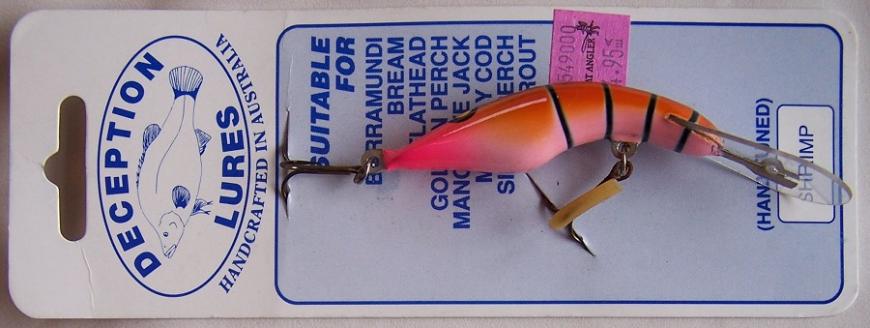
Above shows a full skeleton Deception 'Shrimp' on the card in one of the most popular colours. Printed card. Lure dates to 1990's
The Deception 'Nipper':
The 'Nipper' pattern is a smaller version of the 'Shrimp' and body length is 5cm. It was another of the Deception range that was extremely popular due to its smaller size and its success in fresh and saltwater.
Here are 4 very early, most likely, development Deception Nippers that are quite unique.
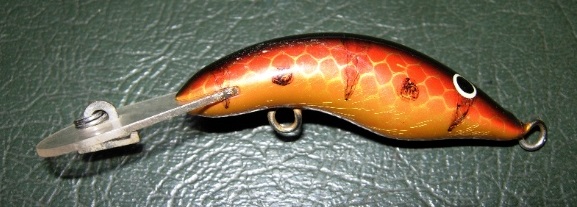
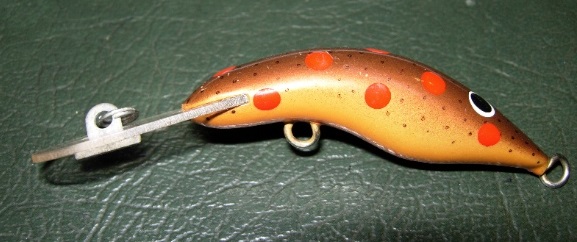
They all have twisted wire hangers which is not typical of the production release models. The Frog Pattern and Orange scale have hand drawn texta markings and the brown trout hand painted red dots. The story behind these is;
"When I got an idea for a new colour pattern, I did
at times draw the markings on with a texta before I went to the trouble
to make spray jigs. That mad cow is more than likely the first''. Paul Kneller.
The mad cow has a 1.5mm bib to accomodate the deeper towpoint and the orange scale has a plastic plate under the towpoint. This was because the bib was only 1mm and this reduced the 'slop' due to the longer pressed towpoints.
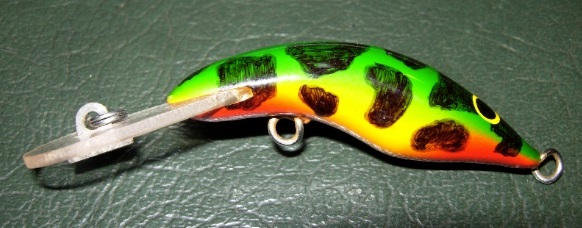
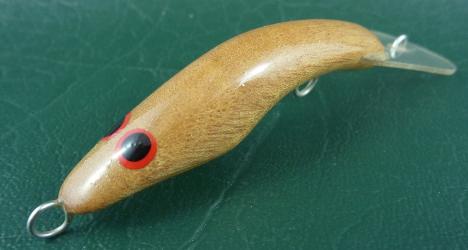
Above - a magnificent 'Nude Nipper'
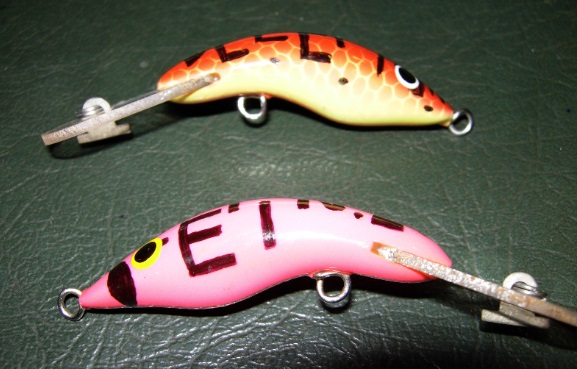
Here is a pair of very early 'twisted wire' Deception Nippers with the word 'Deception' incorporated into the pattern - very unique and fitted with 1.5mm bibs.
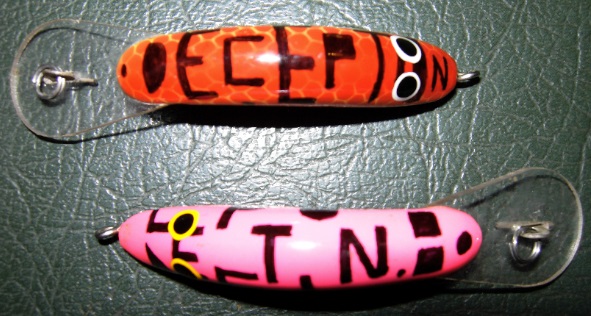
The pressed towpoints are much longer, when compared to the standard and apparently have origins from a handful John Bennett gave Paul early on to try.
Below a carded 'Nipper' that uses screw in eyelets and pressed towpoint. Has Compleat Angler price tag still affixed to card. The lure name has been hand written onto the card where later cards had the name printed on the card.
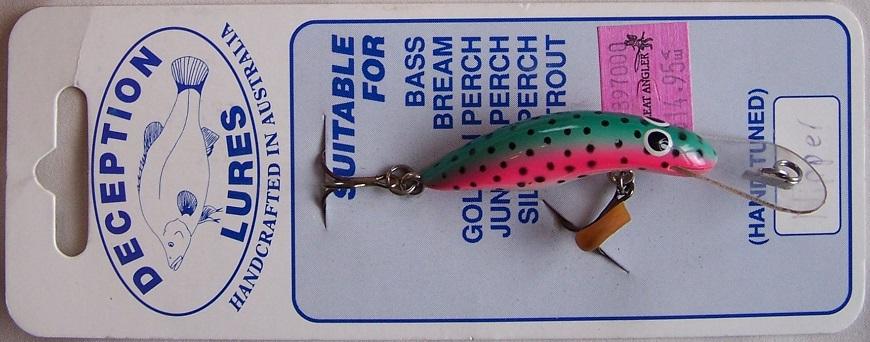
Below - carded 'Nipper' lures showing the difference in bibs on the standard 'Nipper' and the 'Deep Nipper'.
The Deception 'Hornet':
The 'Hornet' pattern was made in 1995 and was never released onto the market. It was only made in small numbers and is the same size as the 'Nipper', basically a shrimp pattern without a polycarbonate bib with the bib built into the lure body in one piece. They were made from white beech. The photo below shows a comparison of the two models
The story behind this model is best explained by Paul;
"I was going to call it a Hornet
but it proved too difficult to machine as the whole lure was made from
one piece of white beech wood. Has a fantastic action, it was kept
because of the dozen or prototypes made this one had the best angle and
action. Caught a few fish while trialling it, then it got put in the
cupboard until now. . . . .I called it the Hornet,
it was going to use it to fund a new Quintrex Hornet, never got around to
producing it but got the Hornet anyway''.
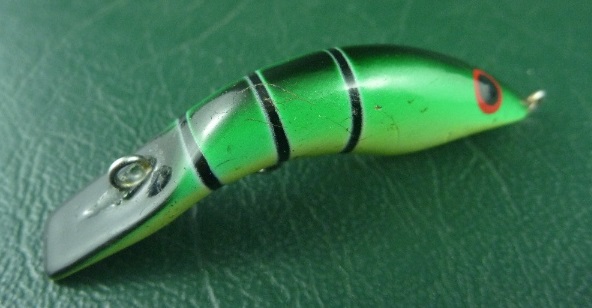
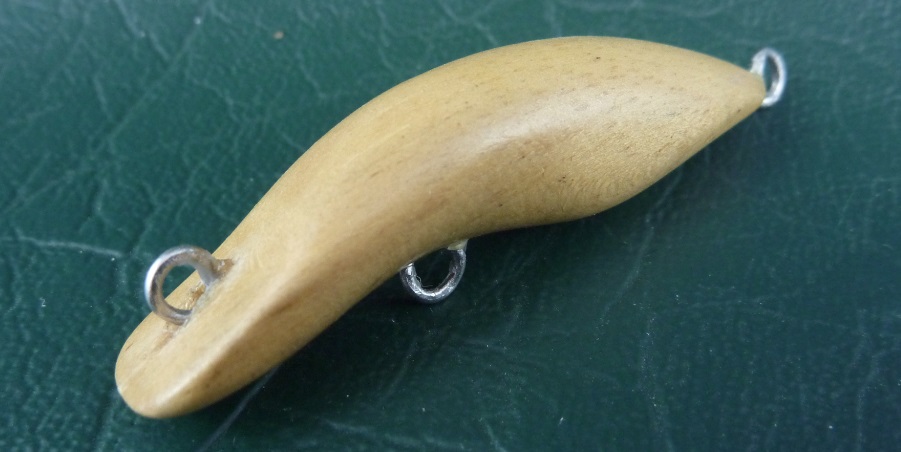
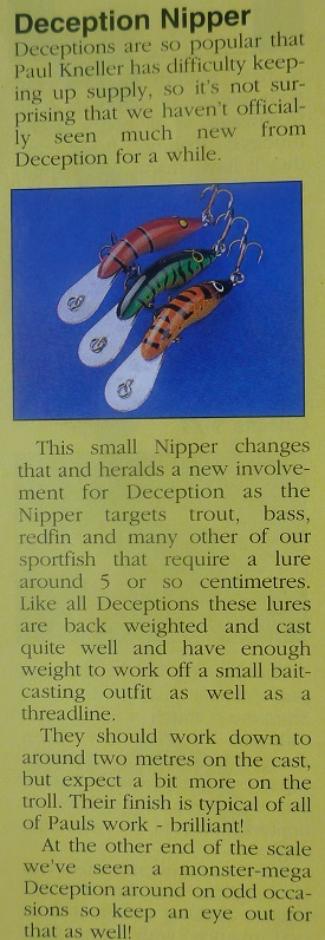

Both of these magazine extracts are from Freshwater Fishing c.1997
The Deception 'Cherabin':
The 'Cherabin' pattern is another model that is larger in size and has a distinct shape with the rings indented into the body of the lure. As shown right there are a number of bib variations however most 'Cherabin' models will be found with the 'fluted' or 'clover' shaped bibs which were originally hand cut as shown below.
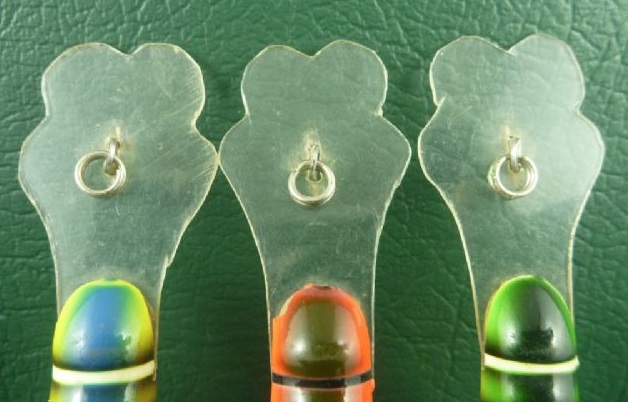
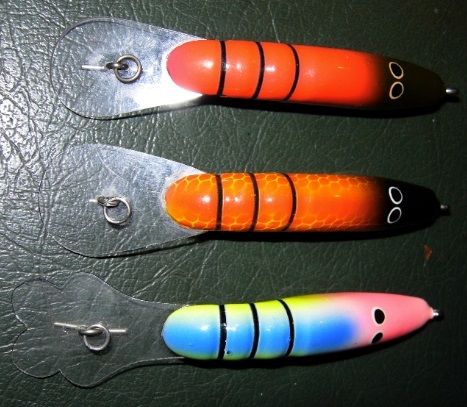
This Cherabin with a shorter fluted bib with the letters N.C. under the epoxy Cherabin with a shorter fluted bib with the letters N.C. under the epoxy
" The Cherabin would have been an early one with a handmade bib, N.C is because I was trialing Nitro Cellulose paint''.
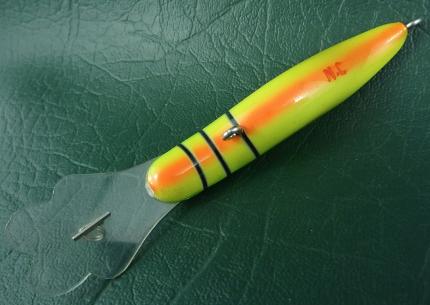
The use of different paints was noted on other lures too such as the examples shown below that are marked 'Pylon' or with the single letter 'P'. Pylon was a range of paints that was around at the time and Paul trialled on his lures.
Below shows three distinct 'Cherabin' variations which have been made.

Fluted 1mm bib - wire insert (above), omega clip (below)

The 'Cherabin' was fitted with both 1mm and 1.5mm fluted bibs but also with standard bibs.

Standard 1 mm bib w/ omega clip

Standard 1 mm bib w/ omega clip

Fluted 1.5 mm bib w/ omega clip

Standard 1.5 mm bib w/ wire insert

Standard 1.5 mm bib w/ wire insert

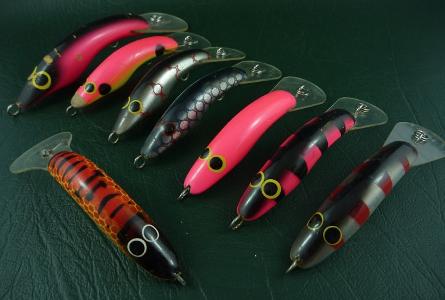
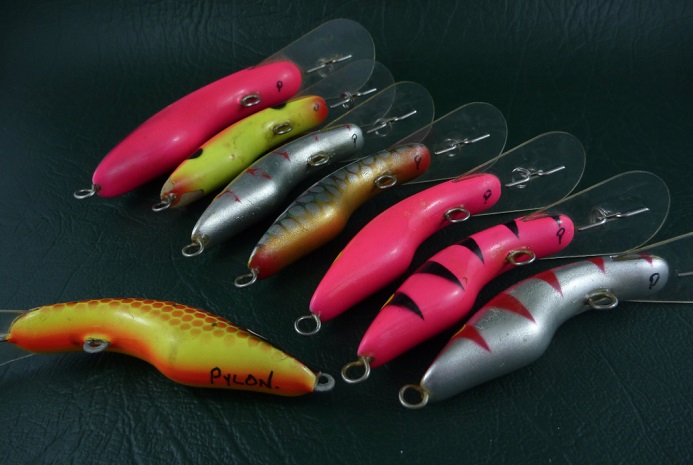
The Deception 'Scampi':
The 'Scampi' - 7 variations, 30 odd colours -
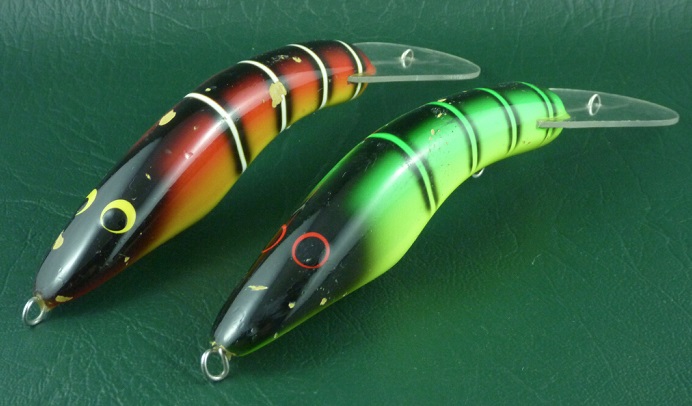
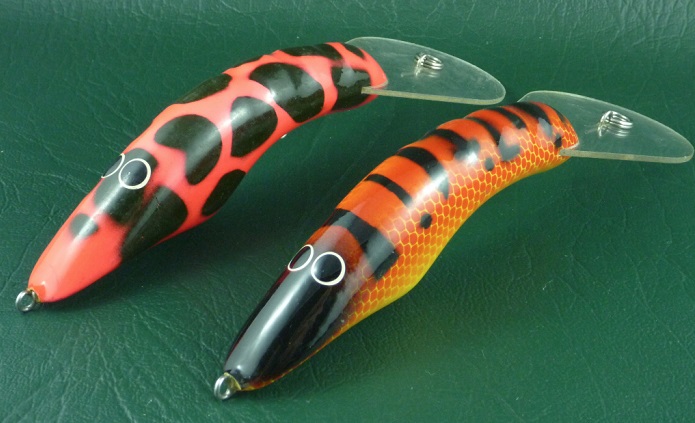
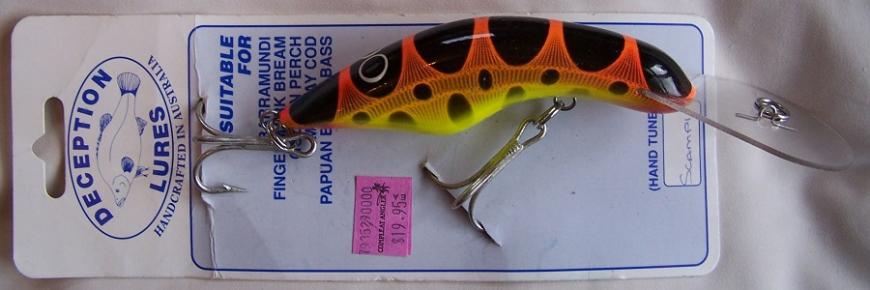
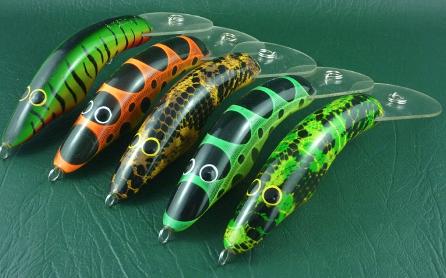
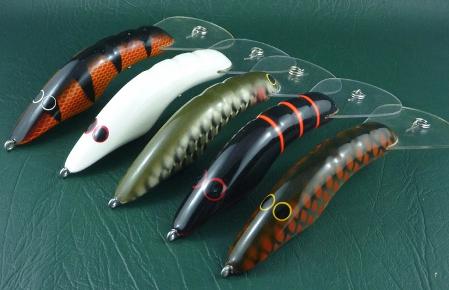
Above shows the 'Rippleback Scampi' and the 'Deep Rippleback Scampi' model is shown below.
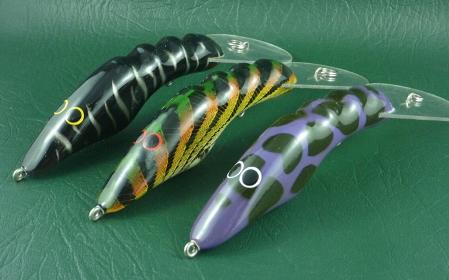
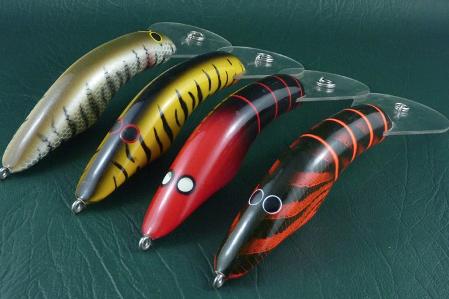
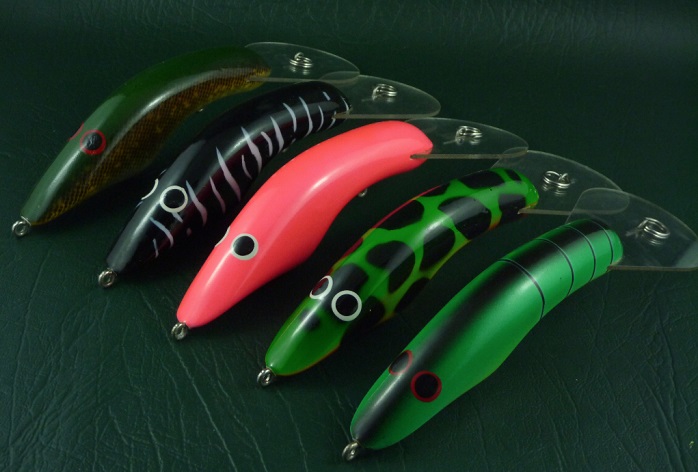
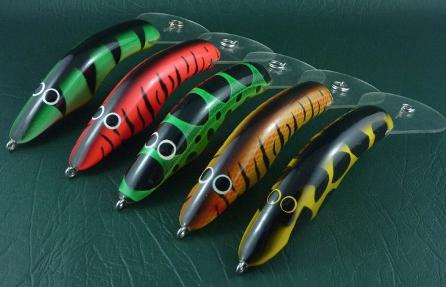
The first will have twisted wire hangers . . .
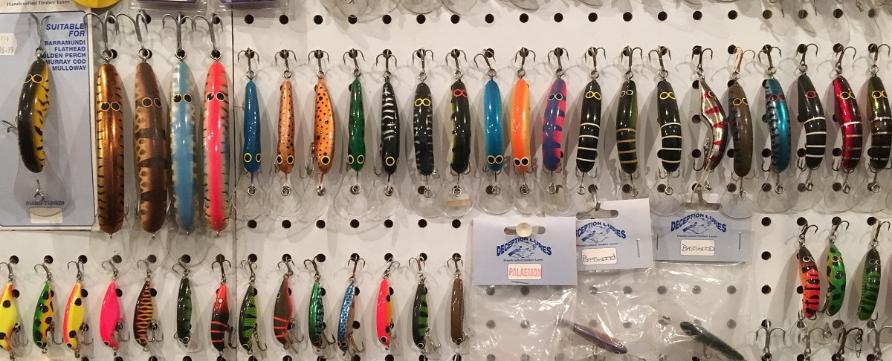
The Deception 'Kadaicha':
Peter Newell's 'Kadaicha/Kadaitcha' is one of the most influential of all Australian lure designs and Paul made a small number of them in 1995 with theintention of using them on a cod fishing trip. There were less than 10 ever made (or is there only 6??)
The following conversation online explains the bib making processes and production of this model.
''I was manager of the toolroom at Nepean Engineering. Graeme worked in the CNC section operating a Mazak machining centre. He gave me the sketch of the bibs you wanted and then we both worked on the programming, once that was done I done the setting up and cutting of the bibs and also the skeleton prototypes for your shrimps and a stack of steel tow points for the nippers. Not sure what happened after I left Nepean, obviously Graeme may have kept making them, not 100% sure but from memory, I made about ten or more bibs for you and the Kad was payment. I fished with Graeme at a special spot at Fitzroy Dam a few times during this period. Anyways, after I left Nepean I went to work Precision Services at Prestons (near Liverpool) which is where you got your press tool made for the skeletons.I still have all the cad design and cam programmes on my computer for the skeleton press tool I worked on.If you require any more info please ask'' Paul Hook
''Ah! Yes it's all coming back now, how the hell are ya? I do remember meeting you a couple of times, and over at Precision and yes that secret Fitzroy spot was a cracker. I think you cut 15 bibs for the Kadaitchas. . . . Actually it was not until I sold Deception to Tacspo that I realised how talented you guys were with CAD and wire cutting me samples, I used a tool shop in Brisbane that literally took dozens of attempts to achieve what you and Graeme did in one hit, A much belated thank you. Cheers Paul.''
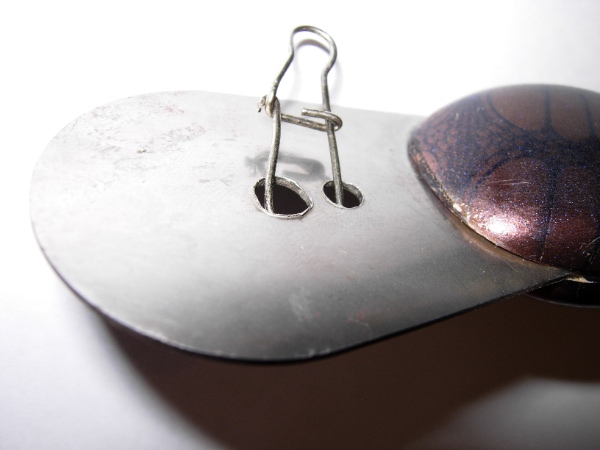
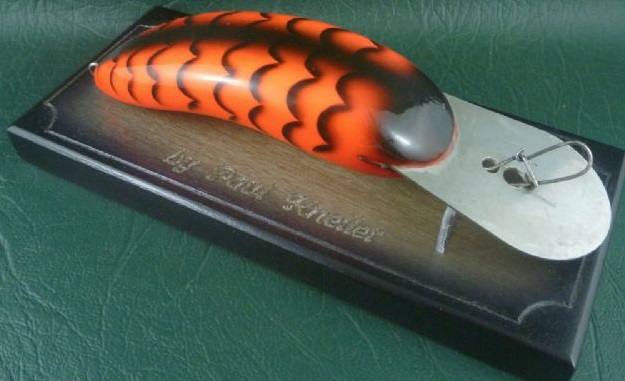
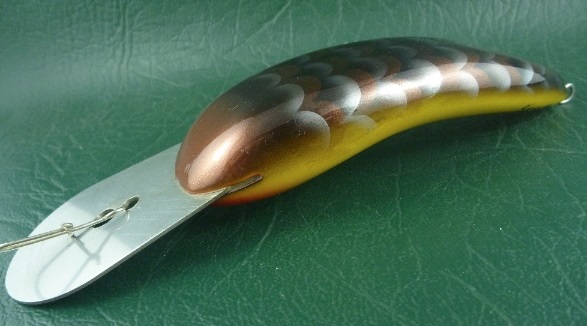
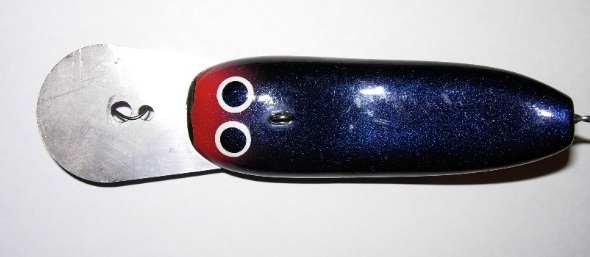
A few examples of the colour patterns that were done on the Deception 'Kadaicha' are shown here. The presentation stand is from later presentation sets not related to this lure.
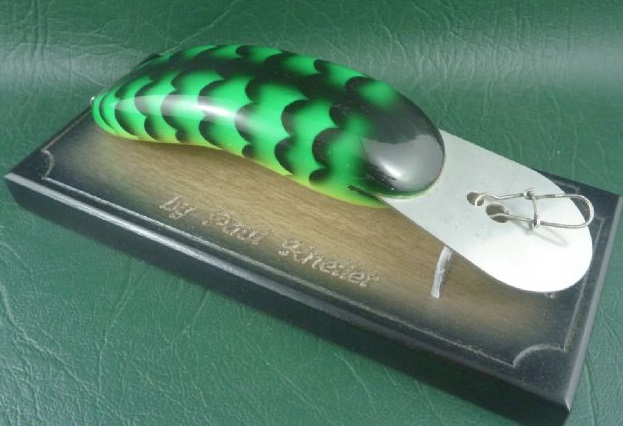
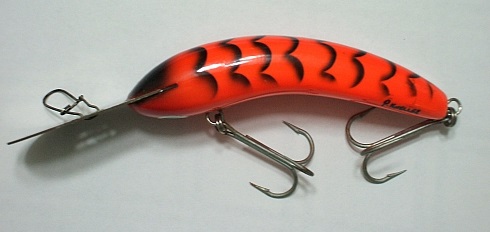
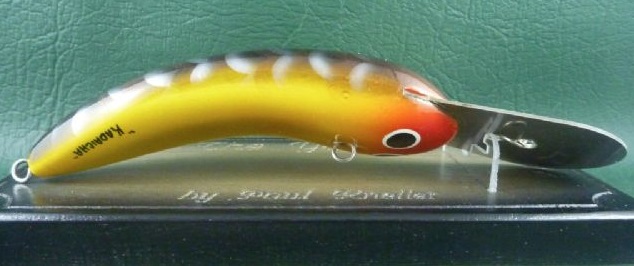
The Deception 'Palaemon'':
More information coming soon . .
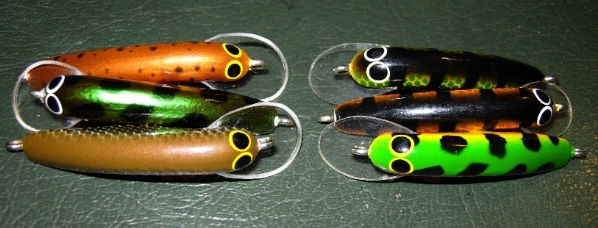
Above shows some Paleamons from the top. There are two bib sizes shown - a standard bib right and the wider and slightly larger bibs on the left group of lures.
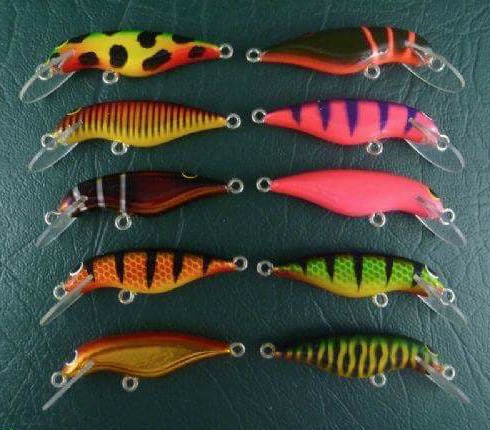
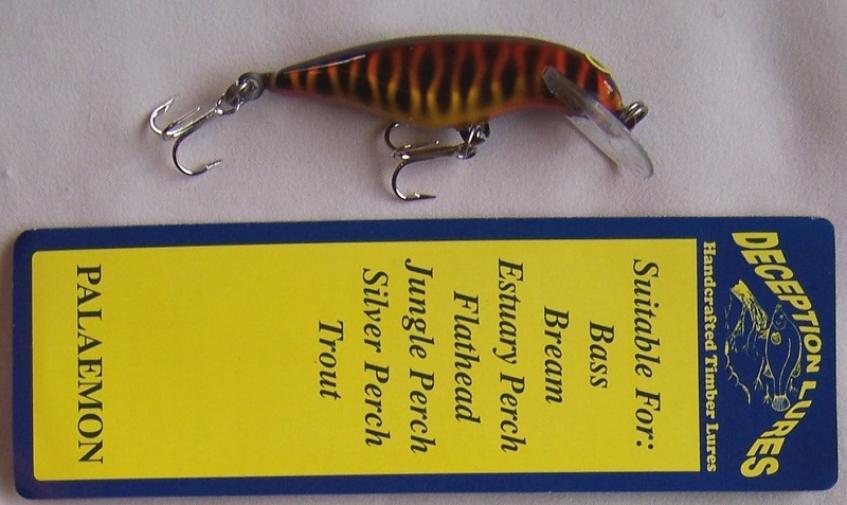
The Deception 'Sardinops':
Coming soon . . .
The Deception 'Basswood':
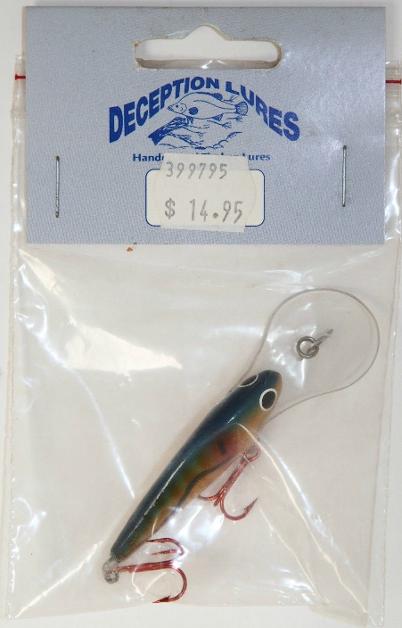
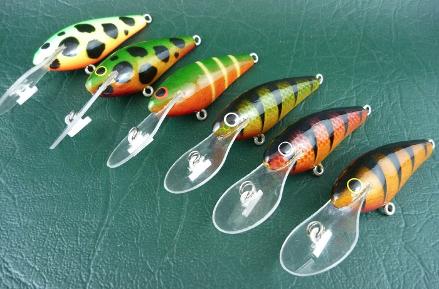
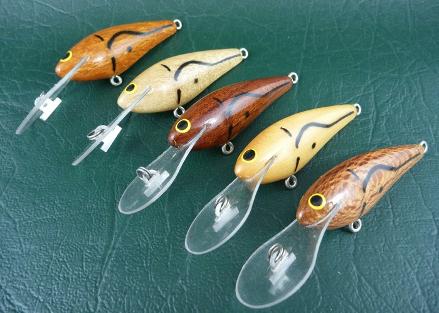
The timbers used for the lures above are from top to bottom - Silky Oak, White Beech, Red Cedar, Huon Pine and Banksia.
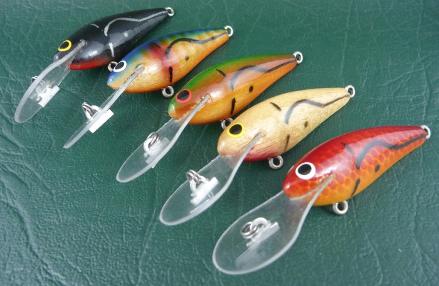
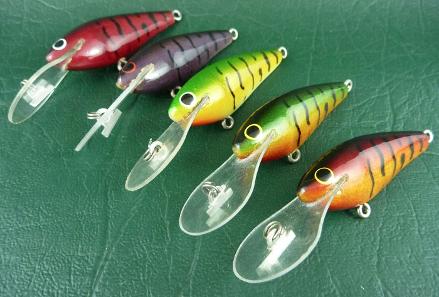
The Deception Surface Lures:
Paul only made six surface style lures as shown;
- Milli Bug
- Dragonfly (reticulated wings)
- Dragonfly (fixed wings)
- Palaemon Prop
- Fizza
- Palaemon Dog
The Deception 'Milli Bug':
Quite a large lure when compared with some of the other surface lure models. Unsure how many were made.
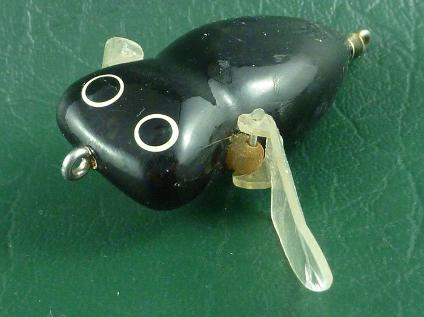
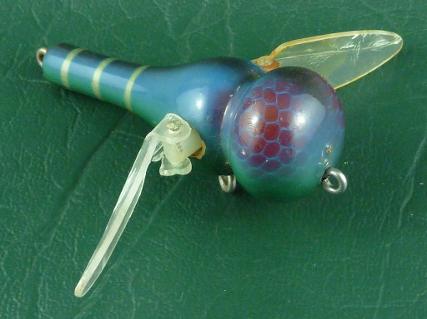
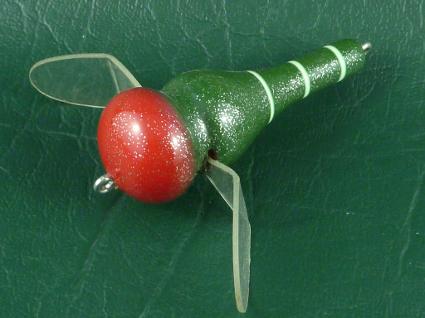
The Deception 'Dragonfly':
These are uncommon and were only ever made in small numbers. There are some other variations as shown.
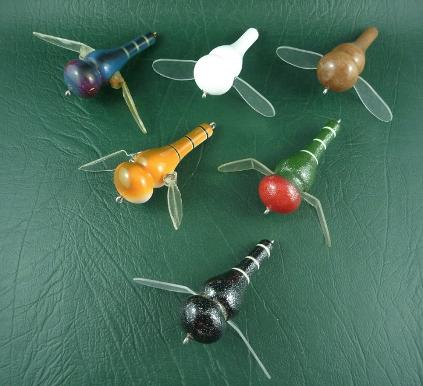
The 'Dragonfly' family
Below shows the small version with the fixed wing arrangement and the articulated wing version
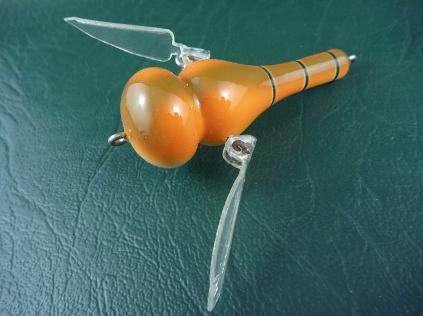
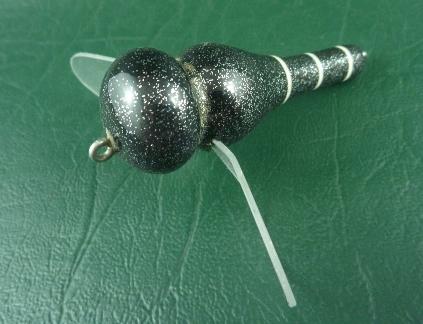
These lures are really all individual as there are minor variations between each of them with bib angles and curvatures etc.
Below shows all the models mentioned above and shows the comparitive sizes of the lures
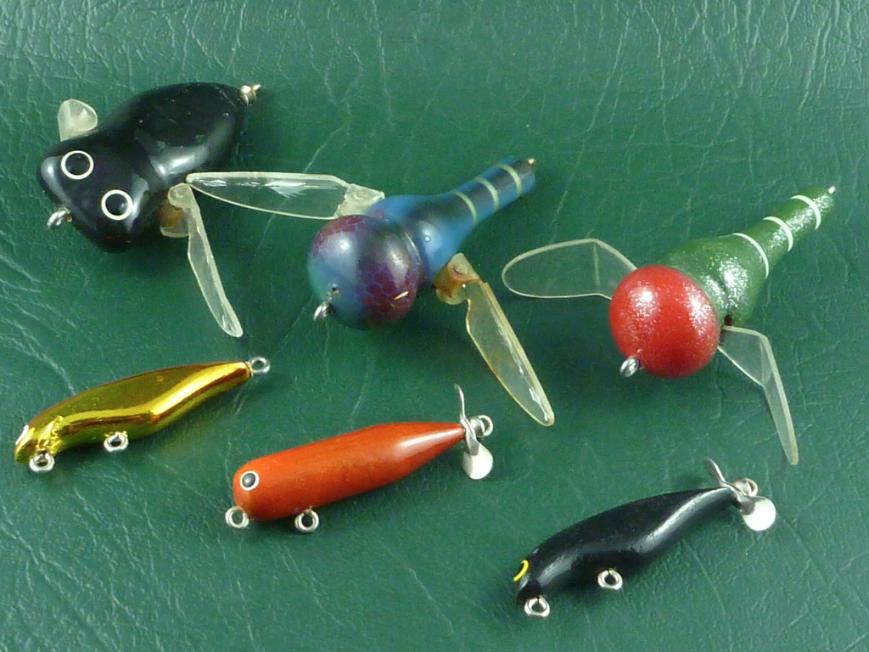
There are a small number of Paul Kneller's creations that are less well known than the previous lures shown because they were made in small numbers or for specific fishing destinations or applications.
The Deception 'Jew':
This is possibly that rarest of Deception lures since it seems to be the only one in existence of this size and jointed that was made for targeting big mulloway (also referred to as 'jewfish'). Apparently the hours/days/weeks spent on making and finishing this lure was part of the reason another one was never made or attempted? There was smaller size made too shown below as a comparison which is also rare. Years made unsure.
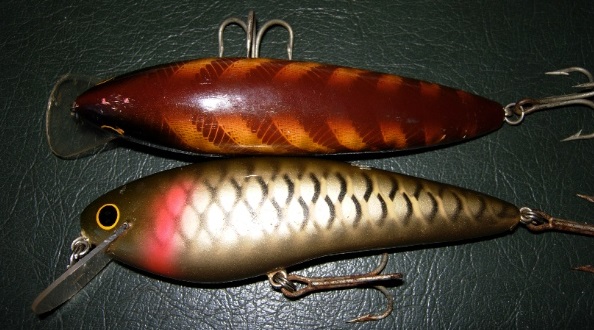
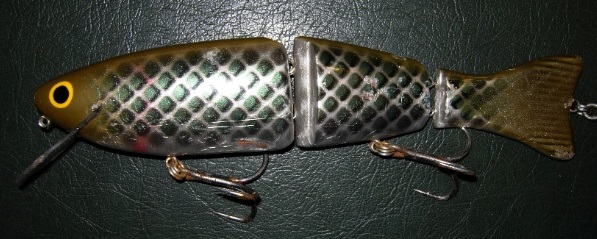
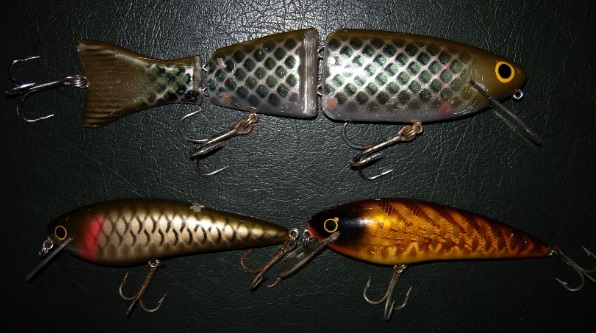
The Deception 'Barra Trip' Lures:
In the year 2000 there were number of lures made by Paul for a planned barramundi fishing trip. Some of these lures remain without specific names but are showcased here . .
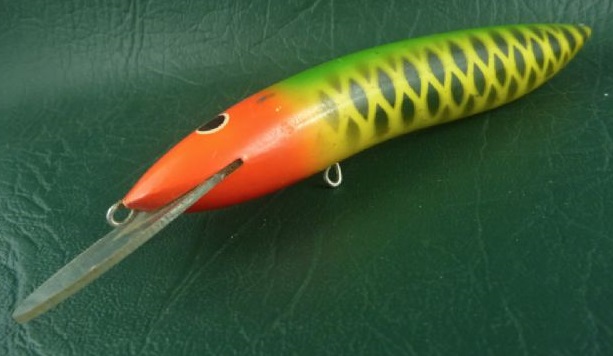
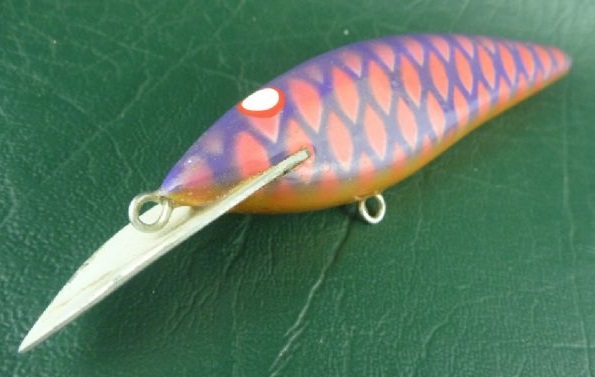
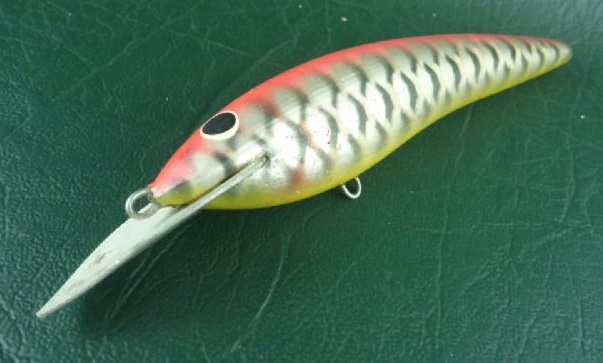
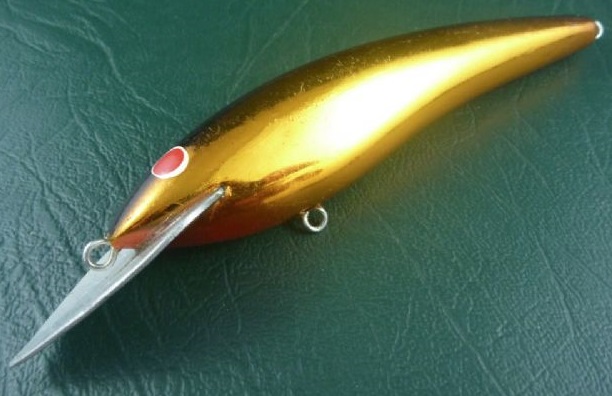
These two lures were done in the 'Gold Bomber' colour which is a classic older colour scheme used on the USA Bomber Lures 'Long A' which was a legendary barramundi lure in the 1980's.
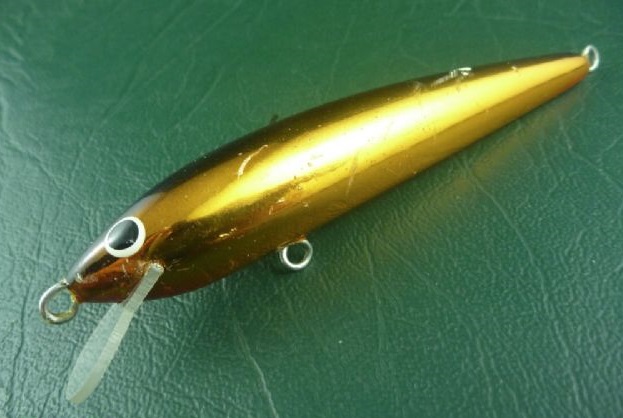
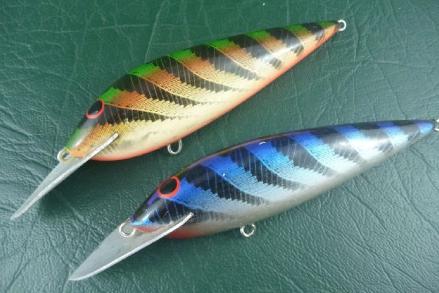
The Deception 'Lancaster ':
Year/history/coming soon
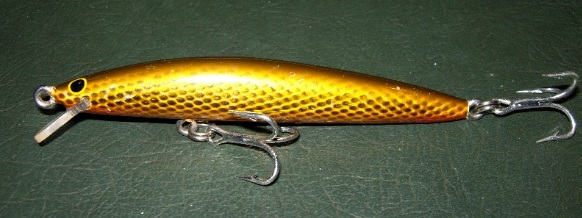
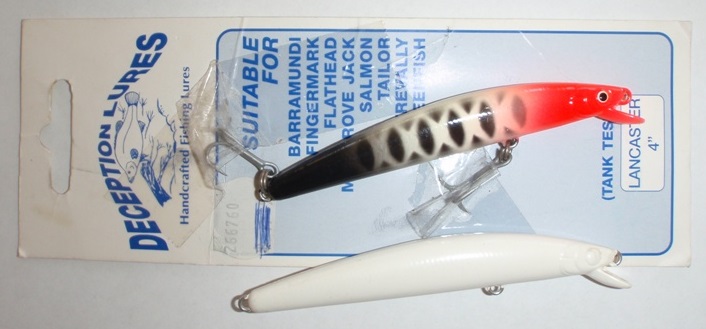
Deception Ephemera:
As Deception Lures has been around for more than 25 years it makes sense that there should be Deception related material that appears form time to time. This includes stickers, hats and special releases. For a full reference of the Deception Anniversary sets see Special Releases
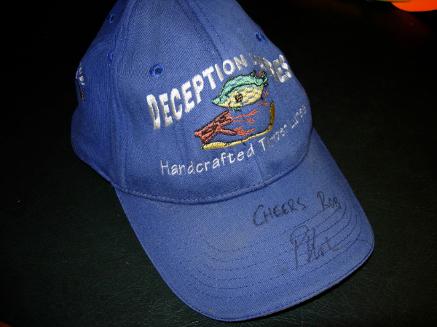
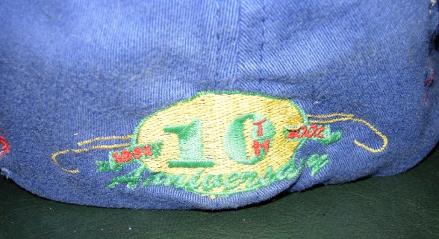
The hat and desk momento celebrate 10 years of Deception Lures being in production from 1992 - 2002. These were done at the same time as releasing the special edition sets.
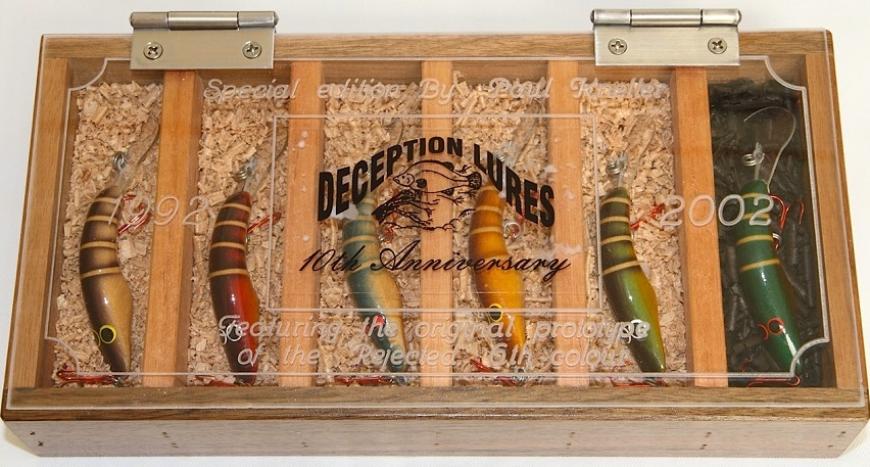
Kneller Lures - Paul Kneller - NSW:
Since 2015 Paul Kneller has been marketing his lures under the Kneller Lures banner and this has included some new releases and some older Deceptioin variations that were not sold to Tacspo.
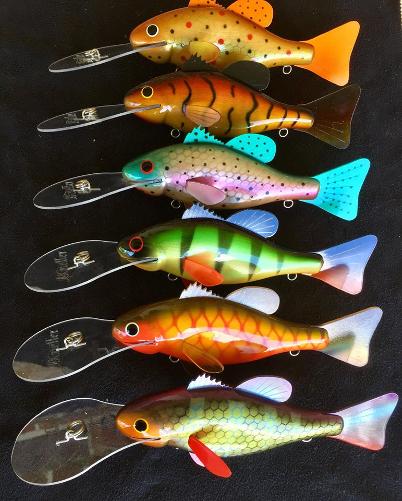
Kneller Cod Walloper 125 which was released in 2017. Shown below is a special edition boxed set of 'Wallopers'
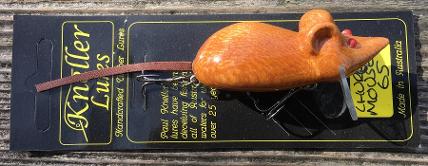
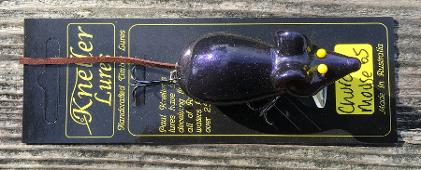
Kneller 'Church Mouse 65' in nude silky oak and a special edition colour that were released at Expo 2018
Kneller 'Red Claw' released mid 2018
